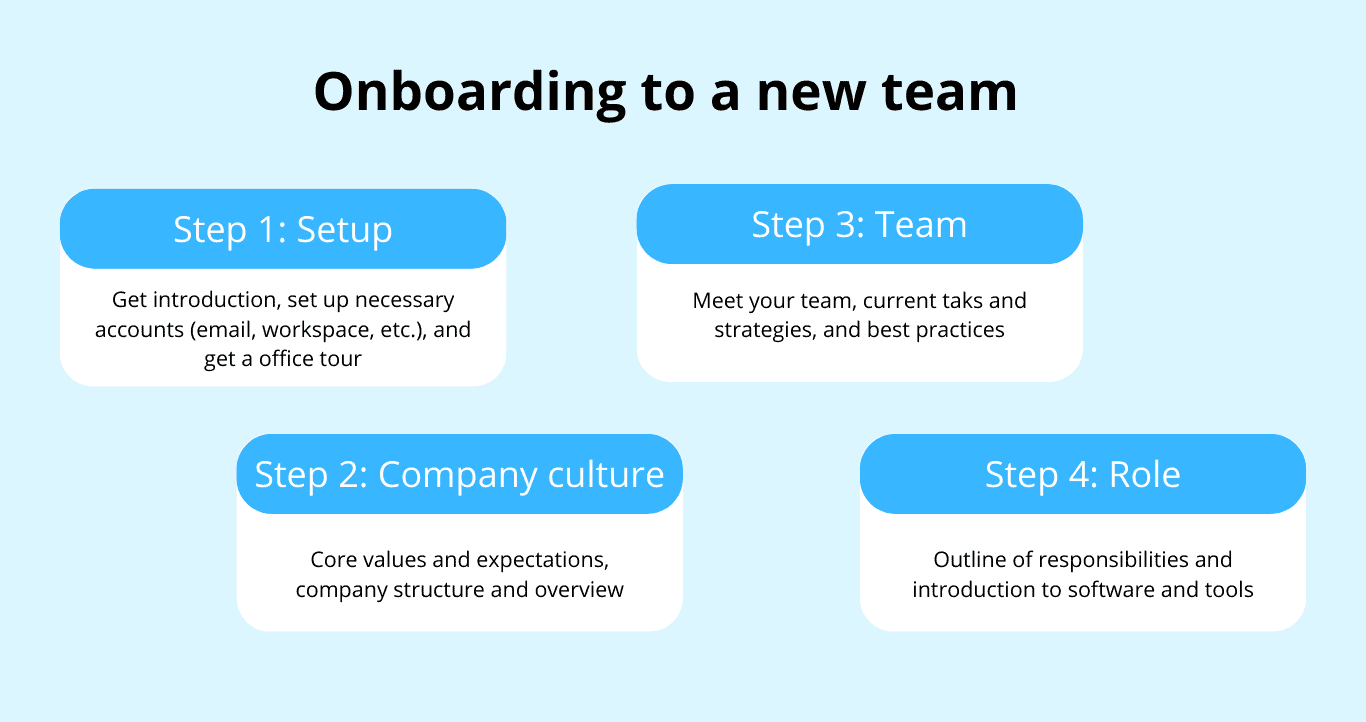An onboarding process is your way of wishing a new hire welcome to the job. You introduce them to the culture and provide them with online courses, workshops, and structured timelines that will provide them with the knowledge and skills necessary to succeed in the position. A good introduction requires an onboarding plan and a toolkit that will ensure productivity and engagement throughout the process. Let us deepdive into what an onboarding process looks like and how you can map out the process to create a good onboarding experience for new hires.
Onboarding 101: What is onboarding?
Onboarding is the process of introducing a new employee to a workplace and presenting the company culture, job responsibilities, and role-specific tasks to them in a supported way. The onboarding process should produce a contributing member of the team, where they get a good understanding of what is required of them, how the company environment is, and get comfortable in their new job.
The onboarding process explained in 4 steps
- Preboarding: Information and assistance in the period after the new hire accepts the job and before the first day on the job. A good practice is to send an email with a dress code, what time to arrive, and who and what to expect on the first day.
- Orientation: Introduction to colleagues, getting familiar with the office, and getting to know the company culture and policies.
- Training: The training of a new employee takes about 3 months, which covers introduction to software, job responsibilities and tasks, and other resources they need to gain the necessary skills for doing the job.
- Integration: The final phase of the onboarding process where the new employee has (hopefully) become a productive and engaged member of the team.
Use an onboarding plan to execute on all the steps
You should map out all the stages of the onboarding activities in an onboarding plan. Consider this the roadmap for how you are going to introduce your new co-worker to their new workplace. It should outline all the elements of the onboarding, from practical set-ups of software or computer accounts, to introduction to company policies and role-specific responsibilities. It is important that the onboarding plan also outlines the goals of the onboarding activities, which should be tailored to the new employee.
This is how you structure your onboarding plan
The onboarding plan should be a resource for you when you onboard a new hire. It will help you keep track of all the things you and your teams need to consider when introducing a new member to your team.
1. Set a goal for the onboarding process
The aim of the onboarding process is for the new colleague to acquire knowledge and skills necessary to become an efficient and natural member of the team. Both in all onboarding processes you should create some detailed goals for the employee. They should set clear expectations and outline the essential skills in the role and how they align with the company culture.
As the employer, you can use these goals to track the progression throughout the onboarding process. It will also be helpful to the new team member, where they will hopefully see a clear connection between position expectations and actual business culture.
2. Invest in the right tools
The tools help you execute on the onboarding plan, which in many ways lay the foundation for achieving the onboarding goals. The tools should make it easier and more comprehensible for the new employee to learn the skills necessary to succeed in the organisation. As the employer, you can use a learning management system (LMS) to organise and structure courses that the new employee can do. This is a great way for him or her to get the necessary knowledge, intuitively and efficiently. The right tool for your company depends on your specific workplace and should reflect what you want to accomplish during the onboarding process.
Get an overview of the different tools you can choose:
- LMS: A LMS allows you to deliver and manage the training sessions, and track the progression of your new hire. Create online courses and gather resources that will benefit the other activities in the onboarding process.
- HR system: You can gather and manage the onboarding plan in an HR system that consists of employee records and information as well.
- Project management tool: Tools like Asana, Teamwork and Trello are helpful tools to keep track of assignments, follow onboarding steps, and track the progression.
- Communication software: Slack or other teamwork communication tools allows you to message, collaborate, and create a casual arena for asking questions while getting to know each other.
Take advantage of a learning management system
3. Map out steps and execute on activities
The actual activities of the onboarding process should be executed in an organised and timely manner. This provides the new hire with a timeline of how they will accomplish their tasks. You should map out the activities during the training period and consider breaking down the tasks into individual goals and processes. This will also make it easier for you to plan and execute on the online courses or learning sessions that you need to organise (more on this in the next step).
4. Plan the online courses
In step 3 and 4 of the onboarding process, it will be necessary to produce some course content for the new hire. An online course can be a life-saver for someone new in the job, which they can use to complement the instructions and guidance given by you and your team. Online learning is also a way for them to process the new information in their own time and get a deeper understanding of how specific tasks and the company ethos are connected.
You should ask yourself the following questions before starting to producing and putting together a new course:
- What do they need to know?
- What do I want them to learn?
- What is their current knowledge level?
- What should be the real outcome of doing the course?
Use this and seek advice from the learning and development department at your company. They will have the resources and experience to produce courses that fit your new hire. Together you should plan for courses that go into depth on some key areas of your department. If the new hire works in the marketing department, you might want to give them a course on how to develop successful marketing strategies or a mini-course on the use of AI in digital marketing. Whatever the field, the online course should be tailored to the target group and designed to create engagement.
Interested in how to create an online course? Read our guide to online courses.
5. Track onboarding metrics
The goals you set in the beginning should be tracked so that you can show your performance. Track key KPIs that align with the overall goals. They should cover these five main areas:
- Completion rates: How many that reached the goals and succeeded (numerically) in the onboarding process.
- Feedback from new hires: As an employer you should always be agile and committed to improve the onboarding plan, for which feedback from the new hire is valuable. Do course evaluations, send out surveys, or hold feedback sessions.
- Time to completion: How many hours it took to complete the onboarding process from start to finish. You can also measure a specific online course.
- Learning effectiveness: The ability of a learning programme to achieve the outcomes and produce the desired results. Measure it through tests or assessments.
- Post-onboarding performance: After the onboarding, the new employee should execute on basic tasks and stay curious to continue learning and developing.

Onboarding should produce engaged and happy co-workers.
Onboarding lays the foundation for performance and well-being
The onboarding process should be a smooth transition for the new employee and give them all the tools and support they need to settle in the new job. You are building a relationship with the new employee during onboarding and laying the groundwork for a successful, happy, and engaged colleague.
Consider the elements of onboarding as building blocks, where you will end up with a fully functional building that can stand on its own and face new, upcoming challenges. The onboarding process leaves the new employee with skills and knowledge necessary to tackle the current roles and responsibilities and face upcoming roadblocks.
Remember that onboarding should be considered and experienced just like the start of any other relationship. Put time and energy into getting to know each other, create an environment where there are no stupid questions and where individual, new needs might appear. The onboarding plan should take this into account and be flexible to adapt to new challenges or demands.
Employee and business performance
Co-workers who are thriving in their job are more likely to perform as well. Higher productivity levels are a natural consequence of a good onboarding experience, where they have gotten access to the toolkit needed to succeed. A happy, productive and efficient employee is a benefit to the entire company and should be counted in the performance scoreboard of the workplace.
Employee retention
Someone who is satisfied with the onboarding process and feels equipped to take on their new job responsibilities will likely stay in the job. Happiness at work increases employee retention, and according to SHRM, people who have had a good onboarding experience are more likely to stay in the job. Research shows that employee retention is boosted by as much as 52 per cent. In addition, people who find their tasks interesting are more likely to engage with the job community and drive engagement at the workplace.
A good onboarding experience should be enjoyable
The onboarding experience should be positive, of course, and reflect the goals that the onboarding plan set forth. We want the new employee to leave the onboarding process fully prepared to take on the responsibilities of their new role. It should be easy, simple, and enjoyable to go through the onboarding process, which you can contribute to by using the right tools.
1. Competent instructors
The people who are responsible for the training should know what they are talking about. The learning must be structured, well-considered, and have clear goals associated with it. There are a plethora of elements to consider when teaching the new employee new skills. One of the most important things to consider is the course design and how this is tailored to the individual learner.
There are many barriers to learning, which will affect the engagement during the courses and the effectiveness of the onboarding process. Please consider the new employee and ensure that you create a course design that aligns with their needs. It goes without saying that you cannot tailor every element to each individual, but most importantly you need to consider it and be able to identify it if problems arise.
2. Accessible training materials
The courses need to be accessible, including having training materials that the new employee can reach for anytime they have questions or need support. The software they use for online training should also be easy to use, and you should be free to give support at any time.
3. Keep the learners engaged throughout
The key to learning is engagement, and people become and remain engaged if they are motivated by the course content or the goals set forth. The content format in the course material should be varied, ideally a mix of text and imagery. Video content or content that drives social interactions are also highly appreciated. If you are onboarding multiple people at the same time, you should use content that drives discussions between them.
4. Feedback should always be possible
Something is bound to go wrong during an onboarding process. Therefore, you should always enable new employees to provide feedback and evaluate the onboarding plan, the LMS or the training materials you provide. This is key to improving the onboarding processes and increasing the likelihood of a smoother onboarding experience next time.

Help your new colleague to succeed in the role.
Features in a LMS that streamline the onboarding process
A LMS is a powerful solution to onboard new employees, because it allows you to deliver, manage and track the progression of new hires in one place. Create and hold courses and make the onboarding process more fluent and interactive. By combining online training with traditional onboarding activities, you take full advantage of the onboarding process and give them an experience that will prepare them for the job.
- Add new hires to the LMS: By integrating your LMS with a HR system or a TMS system, you should be able to add all new learners and create accounts automatically.
- Automate enrollments: You should make a rule in your LMS that all new users should automatically be signed up to certain onboarding courses, like an introductory company culture course.
- Course timelines: All courses should have goals and timeframes associated with them, so that the new hire knows what is expected of them by a certain date. Accomplish this by adding time periods in the LMS.
Check out all the features in the FrontCore LMS that can help the onboarding process.
Did you like this article? Don't forget to share it:







0 Comments